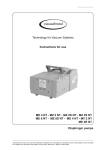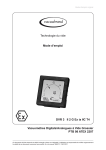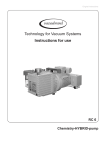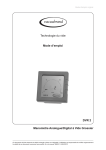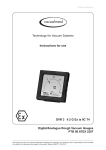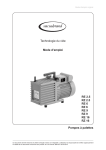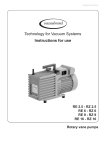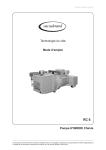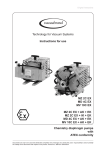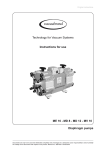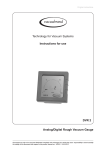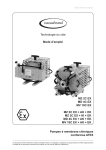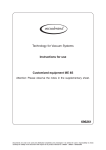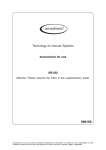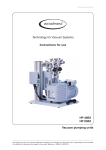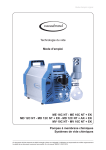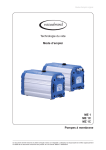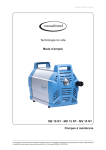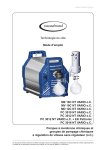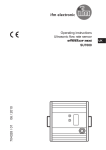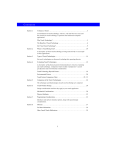Download MZ 2 NT MZ 2D NT
Transcript
page 1 of 59 Technology for Vacuum Systems Instructions for use ME 2 NT - ME 4 NT - ME 4S NT MZ 2 NT - MZ 2D NT - MZ 2S NT ME 8 NT - ME 8S NT - MD 4 NT - MD 4S NT - MV 2 NT ME 4R NT MD 4CRL NT Diaphragm pumps page 2 of 59 Dear customer, Your VACUUBRAND diaphragm pumps are designed to provide you with many years of trouble-free service with optimal performance. Our many years of practical experience allow us to provide a wealth of application and safety information. Please read these instructions for use before the initial operation of your pump. VACUUBRAND diaphragm pumps combine our many years of experience in design, construction and practical operation, with the latest developments in material and manufacturing technology. Our quality maxim is the ”zero fault principle”: Every diaphragm pump, before leaving our factory, is tested intensively, including an endurance run of 18 hours. Any faults, even those which occur rarely, are identified and can be eliminated immediately. After completion of the endurance run, every pump is tested, and must achieve specifications before shipment. We are committed to providing our customers only pumps that meet this high quality standard. While our pumps cannot eliminate all of your work, we design, manufacture and test them to ensure that they will be an effective and trouble-free tool to assist you in that work. Yours, VACUUBRAND GMBH + CO KG After sales service: Contact your local dealer or call +49 9342 808-193. Trademark index: VACUU•LAN® (US-Reg.No 3,704,401), VACUU•BUSTM, VACUU•CONTROLTM, chemistry-HYBRIDTM, PeltronicTM, TURBO•MODETM, VARIO® (US-Reg.No 3,833,788), VARIO-SPTM, VACUUBRAND® (US-Reg.No 3,733,388) and also the shown company logos are trademarks of VACUUBRAND GMBH + CO KG in Germany and/or other countries. page 3 of 59 Contents Safety information!.............................................................. 4 Important information!.......................................................................... 4 General information.............................................................................. 6 Intended use........................................................................................ 6 Setting up and installing the equipment............................................... 7 Ambient conditions............................................................................... 9 Operating conditions.......................................................................... 10 Safety during operation.......................................................................11 Maintenance and repair..................................................................... 14 Additional safety information for ME 4R NT....................................... 15 Intended use...................................................................................... 15 Setting up and installing the equipment............................................. 15 Technical data.................................................................... 17 General technical data valid for all pumps......................................... 17 Gas inlet temperatures...................................................................... 17 Wetted parts...................................................................................... 23 Abbreviations..................................................................................... 24 Pump parts........................................................................................ 25 Use and operation............................................................. 31 Installing a pump in a vacuum system............................................... 31 During operation................................................................................. 35 Shutdown & storage........................................................................... 37 Accessories....................................................................... 38 Troubleshooting................................................................ 39 Replacing diaphragms and valves.................................. 41 Cleaning and inspecting the pump heads......................................... 43 Replacing the diaphragm.................................................................. 45 Assembling the pump heads............................................................. 48 Assembling fittings (ME 4(R) NT, MZ 2(D, S) NT, MD 4CRL NT).................... 49 Replacing the fuse............................................................................ 51 Notes on return to the factory.......................................... 52 Warranty............................................................................. 55 Health and safety clearance form.................................... 56 EC Declaration of Conformity of the Machinery . .............. 57 page 4 of 59 Safety information! Important information! NOTICE This manual is an integral part of the equipment described therein. It describes the safe and proper use of the vacuum pump. Keep this manual complete and accessible to personnel at all times! Make operating personnel aware of dangers arising from the pump and the pumped substances. Read this manual carefully before installing or operating the equipment. Observe the instructions contained in this manual. VACUUBRAND disclaims any liability for inappropriate use of these pumps and for damage resulting from disregarding the instructions contained in this manual. Do not modify the equipment without authorization. This manual is only to be used and distributed completely and unchanged. It is strictly the users’ responsibility to check carefully the validity of this manual with respect to his product. Manual-no.: 999155 / 07/06/2011 The following signal word panels and safety symbols are used throughout this manual: This is the safety alert symbol. It is used to alert you to potential personal injury hazards. Obey all safety messages that follow this symbol to avoid possible injury and death. page 5 of 59 ➨DANGER indicates a hazardous situation which, if not avoided, will result in death or serious injury. +WARNING indicates a hazardous situation which, if not avoided, could result in death or serious injury. NOTICE • CAUTION indicates a hazardous situation which, if not avoided, could result in minor or moderate injury. NOTICE is used to address practices not related to personal injury. Caution! Hot surface! Disconnect equipment from AC power. Formatting used in this manual: Note: The signal word panels in all sections of this manual always refer to all paragraphs of the same format (➨ / + / • / plain text) following each signal word panel. page 6 of 59 General information NOTICE Remove all packing material from the packing box. Remove the product from its packing-box and retain all packaging until the equipment is inspected and tested. Remove the protective caps from the inlet and outlet ports and retain for future use. Inspect the equipment promptly and carefully. If the equipment is damaged, notify the supplier and the carrier in writing within three days. Retain all packing material for inspection. State the item number of the product together with the order number and the supplier’s invoice number. Failure to check and give notice of damage will void any and all warranty claims for those deficiencies. Replace the protective caps, if the equipment is not used immediately. Store the equipment in dry and non-corrosive conditions (see also ”Technical data”, pg. 17). Use the mounted handle when moving the pump. +Do not use any damaged equipment. Intended use ☞Do not use the pump or any system parts on humans or animals. ☞Prevent any part of the human body from coming into contact with vacuum. ☞Ensure that the individual components are only connected, combined and operated according to their design and as indicated in the instructions for use. ☞Comply with all notes on correct vacuum and electrical connections; see section ”Use and operation”, pg. 31. +Use the equipment only as intended, that is, for generation of vacuum in vessels designed for that purpose. Any other use will automatically invalidate all warranty and liability claims. Remain aware of safety and risks. +Do not use the pump to generate pressure. page 7 of 59 NOTICE The pumps are designed for ambient temperatures during operation between +50°F and +104°F (+10°C and +40°C). Check the maximum temperatures if installing the pump in a cabinet or a housing. Make sure ventilation is adequate to maintain recommended operating temperature. Install an external automatic ventilation system if necessary. If pumping hot process gases, make sure that the maximum permitted gas inlet temperature is not exceeded. The maximum permitted gas inlet temperature depends on several parameters like inlet pressure and ambient temperature (see ”Technical data”, pg. 17). Do not aspirate particles and dust. Do not pump liquids. Ensure that the pump is chemically resistant to the pumped substances prior to operation. Setting up and installing the equipment ➨Equipment must be connected only to a suitable electrical supply and a suitable ground point. As such, the plug must be plugged into an outlet that is properly grounded. Failure to connect the motor to ground may result in deadly electrical shock. The supply cable may be fitted with a molded European IEC plug or a plug suitable for your local electrical supply. The cable contains wires color coded as follows: green or green and yellow: ground; blue or white: neutral; brown or black: hot. ☞Due to the high compression ratio, the pump may generate overpressure at the outlet. Check pressure compatibility with system components (e.g., exhaust pipeline or exhaust valve) at the outlet. ☞Do not permit any uncontrolled pressurizing. Make sure that the exhaust pipeline cannot become blocked. If there is an exhaust isolation valve, make sure that you cannot operate the equipment with the valve closed to page 8 of 59 avoid a risk of bursting! ☞Always provide a free and pressureless exhaust outlet to avoid damage to pump valves and risk of bursting. • Provide a firm, level platform for the equipment. Check that the system which you are going to evacuate is mechanically stable. Check that all fittings are secure. Ensure a stable position of the pump without any mechanical contact other than the pump feet. Comply with all applicable safety regulations. • Comply with maximum permissible pressures at inlet and outlet and with maximum permissible pressure differences between inlet and outlet. See section ”Technical data”, pg. 17. Do not operate the pump with overpressure at the inlet. • Avoid overpressure of more than 17.5 psi absolute (1.2 bar absolute) in the event that inert gas is connected to the pump, or to a venting valve. • Keep the electrical power cord away from heated surfaces. • Note: Flexible elements will shrink when evacuated. NOTICE Check the power source and the pump’s rating plate to be sure that the power source and the equipment match in voltage, phase, and frequency. On pumps with a dual-voltage motor, check that the voltage selection switch is set correctly. Do not change the setting of the voltage selection switch while the pump is connected to AC power. Unplug the pump before setting the voltage selection switch. Note: If the pump is switched on with wrong voltage selection, the motor may be damaged! Keep a minimum distance of 8 in (20 cm) between the cooling fan and surrounding items (e.g., housing, walls, etc.). Check fan regularly for dust/dirt. Clean fan guard grill if necessary to avoid a reduction of ventilation. page 9 of 59 Use only hoses at the inlet and outlet of the pump with an inner diameter at least as large as the diameter of the pump’s tubing (to avoid overpressure at the outlet, and reduction of pumping speed at the inlet). Connect hoses gas tight at inlet and outlet of the pump. Allow the equipment to equilibrate to ambient temperature if you bring it from cold environment into a room prior to operation. Notice if there is water condensation on cold surfaces. Ensure that no foreign objects can be drawn into the pump. Comply with all applicable and relevant safety requirements (regulations and guidelines). Implement the required actions and adopt suitable safety measures. Ambient conditions +Do not use this product in an area where it can fall or be pulled into water or other liquids. ➨Do not reach for this product if it has fallen into liquid. There is a risk of deadly electrical shock. Unplug the system immediately. NOTICE To the best of our knowledge the equipment is in compliance with the requirements of the applicable EC-directives and harmonized standards (see ”Declaration of Conformity”) with regard to design, type and model. Directive EN 61010-1 gives in detail the conditions under which the equipment can be operated safely (see also IP degree of protection, ”Technical data”, pg. 17). Adopt suitable measures in case of differences from recommended conditions, e.g., using the equipment outdoors, installation in altitudes of more than 3300 ft (1000 m) above mean sea level, conductive pollution or external condensation on the pump. page 10 of 59 Pay attention to the permissible maximum ambient and gas inlet temperatures (see ”Technical data”, pg. 17). Do not operate this product near flames. Operating conditions ➨These pumps are not approved for operation in potentially explosive atmospheres. Do not operate the pumps in potentially explosive atmospheres. ➨These pumps are not approved for the pumping of potentially explosive atmospheres. Do not pump potentially explosive atmospheres. ➨The pumps are not suitable to pump any of the substances listed below. Do not pump: - unstable substances - substances which react explosively under impact (mechanical stress) without air - substances which react explosively when being exposed to elevated temperatures without air, - self inflammable substances, - substances which are inflammable without air - explosive substances. NOTICE Do not pump substances which may form deposits inside the pump. The pumps are not suitable for pumping substances which may form deposits inside the pump. Deposits and condensate in the pump may lead to increased temperatures even to the point of exceeding the maximum permitted temperatures. Check the inlet and outlet of the pump, if there is a danger of forming deposits inside the pump, e.g., in the pump chambers (the pump chamber is the part between diaphragm and head cover. See section ”Replacing diaphragms and valves”, pg. 41). Inspect the pump chambers regularly and clean if necessary. page 11 of 59 The pumps are not suitable for pumping dust and they are not approved for operation below ground. Do not pump dust and do not operate the pump below ground. When changing the substances pumped, we recommend to purge the pump with air or inert gas prior to changing the pumped media. Purging the pump will pump out residues and it will reduce the possibility of reactions of the pumped substances with each other and with the pump’s materials. Consider interactions and chemical reactions of the pumped media. Ensure that the materials of the pump’s wetted parts are compatible with the pumped substances, see section ”Technical data”, pg. 17. Safety during operation ➨Adopt suitable measures to prevent the release of dangerous, toxic, explosive, corrosive, noxious or polluting fluids, vapors and gases. To prevent any emission of such substances from the pump outlet, install an appropriate collecting and disposal system and take protective action for pump and environment. +Never operate this pump if it has a damaged cord or plug. If the pump is not working properly, has been dropped or has fallen into water, contact your pump service provider. +Prevent any part of the human body from coming into contact with vacuum. +Make sure that the exhaust pipeline cannot become blocked. +You must take suitable precautions to prevent any formation of explosive mixtures in the pump chamber or at the outlet of the pump. In case, e.g., of a diaphragm failure, mechanically generated sparks, hot surfaces or page 12 of 59 static electricity may ignite these mixtures. Use inert gas for venting, if necessary. +Drain appropriately or otherwise remove any potentially explosive mixtures at the outlet of the pump, or dilute them with inert gas to non-explosive concentrations. +Comply with applicable regulations when disposing of chemicals. Take into consideration that chemicals may be contaminated. Take adequate precautions to protect people from the effects of dangerous substances (chemicals, thermal decomposition products of fluoroelastomers). Use appropriate protective clothing and safety goggles. +Use only original manufacturer’s spare parts and accessories. Otherwise the safety and performance of the equipment, as well as the electromagnetic compatibility of the equipment might be reduced. The CE mark or the cTÜVus mark may be voided if not using original manufacturer’s spare parts. • Ensure that no parts of your clothing, hair or fingers can be caught or drawn in at the inlet of the pump. Never insert fingers or drop any other object into the inlet or outlet. • Pay attention to the safety symbol ”hot surfaces” on the equipment. Hot parts may cause burns if touched. Adopt suitable measures to prevent any danger arising from hot surfaces or electric sparks. Ensure that hot surfaces of the pump do not cause burns. Provide a suitable contact guard if necessary. • Failure of the pump (e.g., due to power interruption), failure of connected components or of parts of the supply, or a change of parameters must not be allowed to lead to a dangerous situation under any circumstances. In case of a diaphragm failure or in case of a leak in the manifold, pumped substances might be released into the environment or into the pump housing or motor. Especially comply with notes on use and operation and page 13 of 59 maintenance. • The residual leak rate of the equipment might render possible an exchange of gas, albeit extremely slight, between the environment and the vacuum system. Adopt suitable measures to prevent contamination of the pumped substances or the environment. NOTICE Do not start the pump if the pressure difference between inlet and outlet exceeds 16 psi (1.1 bar) at maximum. Prevent the backpressure of gases and the backflow of condensates at the outlet. Never aspirate liquids or dust into the pump. Provide appropriate protective measures to allow for the possibility of failure and malfunction. The protective measures must also allow for the requirements of the respective application. In case of overload, the motor is shut down by a self-hold thermal cutout in the winding. Note: Only manual reset is possible. Switch off the pump and disconnect from the power source. Identify and eliminate the cause of failure. Wait approx. five minutes before restarting the pump. • Note: In case of supply voltage below 100V, the lock of the cutout might be impaired and the pump may restart on its own after sufficient cooling down. Take appropriate precautions, if an automatic restart of the pump may lead to a dangerous situation. page 14 of 59 Maintenance and repair NOTICE In order to comply with laws (occupational, health and safety regulations, safety at work law and regulations for environmental protection) vacuum pumps, components and measuring instruments can only be returned when certain procedures (see section ”Notes on return to the factory”, pg. 52) are followed. Take advantage of our service seminars, which put special focus on the maintenance and repair of vacuum pumps. For details see www.vacuubrand.com. Wear parts have to be replaced regularly. In case of normal wear, the lifetime of the diaphragms and valves is > 10000 operating hours. Bearings have a typical durability of 40000 h. Motor capacitors have a typical durability in the range of 10000 to 40000 h depending strongly on operation conditions including ambient temperature, humidity or load. ☞Ensure that the pump cannot be operated accidentally. Never operate the pump if covers or other parts of the pump are disassembled. Never operate a defective or damaged pump. +Switch off the pump. Disconnect the electrical power cord and wait two minutes before starting maintenance to allow the capacitors to discharge. ☞Note: The pump may be contaminated with process chemicals, which have been pumped during operation. Ensure that the pump is completely decontaminated before maintenance commences. Take adequate precautions to protect people from the effects of dangerous substances if contamination has occurred. Use appropriate protective clothing, safety goggles and protective gloves. • Check every motor capacitor regularly by measuring page 15 of 59 its capacity and estimating its time in operation. Replace old capacitors early enough to prevent a failure in operation. If an old motor capacitor fails, the capacitor may get hot. It may even melt or emit a flame, which could be dangerous for persons and equipment in the vicinity. The capacitors have to be replaced by an electrician. • Vent the pump before starting maintenance. Isolate the pump and other components from the vacuum system. Allow sufficient cooling of the pump. Drain condensate, if applicable. • Ensure that maintenance is done only by suitably trained and supervised technicians. Ensure that the maintenance technician is familiar with the safety procedures, which relate to the products processed by the pumping system. Only dismantle the pump as far as necessary. Additional safety information for ME 4R NT Intended use ☞Comply with all notes on how to connect the ME 4R NT correctly to vacuum and pressure systems; see section ”Use and operation”, pg. 31. +Use the equipment only as intended, that is, for generation of vacuum or for compression of gases in vessels designed for that purpose. Any other use will automatically invalidate all warranty and liability claims. Remain aware of safety and risks. Setting up and installing the equipment ☞When operating the pump as a compressor, check that the system which you are going to pressurize is mechanically stable. Check that the maximum gener- page 16 of 59 ated overpressure is compatible with the mechanical stability of the pressure vessel. Do not generate overpressure in vessels other than in those designed for that purpose. Risk of bursting! Comply with maximum permissible pressure at the outlet (58 psi (4 bar) absolute). The pump has an overpressure safety relief device at the pressure adjustment device at the outlet (opening pressure: 58 psi (4 bar) absolute). Install an additional overpressure safety relief device in the pressure system, if necessary. Note: Flexible elements will expand when pressurized. ☞Do not permit any uncontrolled pressurizing. Make sure that the exhaust pipeline cannot become blocked. ☞Especially when using the pump as vacuum pump provide a free and pressureless exhaust outlet to avoid damage to pump valves and risk of bursting. • Comply with maximum permissible pressures at inlet and outlet and with maximum permissible pressure differences between inlet and outlet. See section ”Technical data”, pg. 17. Do not start the pump with overpressure at the inlet. page 17 of 59 Technical data General technical data valid for all pumps Permissible ambient temperature storage / operation °F (°C) Permissible relative atmospheric moisture during operation (no condensation) No-load speed 50/60 Hz % rpm Device fuse 14 to 140 / 50 to 104 (-10 to +60 / +10 to +40) 30 to 85 1500 / 1800 slow blow fuse 6.3 A Motor protection thermal cutout, manual reset Degree of protection IEC 529 A-weighted emission sound pressure level* (uncertainty KpA: 3 dB(A)) IP 40 dB(A) 45 * Measurement according to EN ISO 2151:2004 and EN ISO 3744:1995 at 230V/50Hz and ultimate vacuum with silencer at outlet. Gas inlet temperatures Operating condition Inlet pressure Continuous operation > 75 Torr (100 mbar) (high gas load) < 75 Torr (100 mbar) (low gas load) < 75 Torr (100 mbar) (low gas load) Continuous operation Short-time (< 5 minutes) Permitted range of gas temperatures at inlet ➨ 50 °F to 104 °F (+10°C to +40°C) ➨ 32 °F to 140 °F (0°C to +60°C) ➨ 14 °F to 176 °F (-10°C to +80°C) We reserve the right for technical modification without prior notice! page 18 of 59 Type ME 4 NT ME 4S NT MZ 2 NT MZ 2S NT 2.4 / 2.6 (4.0 / 4.4) 1.3 / 1.4 (2.2 / 2.4) 1.2 / 1.4 (2.0 / 2.3) 5.2 (7) 5.2 (7) Maximum pumping speed 50/60 Hz (ISO 21360) cfm (m3/h) Ultimate vacuum (absolute) 52 (70) Torr ME 4S NT: (mbar) 56 (75) Maximum permissible inlet pressure (absolute) psi (bar) 16 (1.1) Maximum permissible outlet pressure (absolute) psi (bar) 29 (2) Maximum pressure difference between inlet and outlet psi (bar) 29 (2) Rated motor power hp (kW) Maximum permissible range of supply voltage ( ±10% ) Attention: Observe specifications of rating plate! 100-115 V~ 50/60 Hz, 120V~ 60 Hz Dual voltage motor 100-115 V~ 50/60 Hz, 120 V 60 Hz / 200-230 V~ 50/60 Hz Maximum rated current at: 100-115 V~ 50/60 Hz, 120 V~ 60 Hz 200-230 V~ 50/60 Hz 230 V~ 50/60 Hz 0.24 (0.18) 230 V~ 50/60 Hz A 3.4 A A 1.8 1.8 hose nozzle for tubing I.D. 3/8" (hose nozzle DN 10 mm) Inlet Outlet silencer / G1/4” Dimensions L x W x H approx. in (mm) 9.6 x 9.4 x 7.8 (243 x 239 x 198) Weight approx. lbs. (kg) 24.2 (11.0) page 19 of 59 Type MZ 2D NT ME 8 NT ME 8S NT Maximum pumping speed 50/60 Hz (ISO 21360) cfm (m3/h) 1.4 / 1.5 (2.3 / 2.5) 4.3 / 4.8 (7.3 / 8.1) 4.2 / 4.6 (7.1 / 7.8) Ultimate vacuum (absolute) Torr (mbar) 3 (4) 52 (70) 52 (70) Maximum permissible inlet pressure (absolute) psi (bar) 16 (1.1) 16 (1.1) Maximum permissible outlet pressure (absolute) psi (bar) 16 (1.1) 29 (2) Maximum pressure difference between inlet and outlet psi (bar) 16 (1.1) 29 (2) Rated motor power hp (kW) 0.24 (0.18) Maximum permissible range of supply voltage ( ±10% ) Attention: Observe specifications of rating plate! 100-115 V~ 50/60 Hz, 120V~ 60 Hz - 0.34 (0.25) 100 V~ 50/60 120 V~ 60 230 V~ 50/60 Hz Dual voltage motor Maximum rated current at: 100 V~ 50/60 Hz 120 V~ 60 Hz 230 V~ 50/60 Hz 100-115 V~ 50/60 Hz, 120 V~ 60 Hz 200-230 V~ 50/60 Hz Inlet Outlet Dimensions L x W x H approx. Weight approx. 100-115 V~ 50/60 Hz, 120 V 60 Hz / 200-230 V~ 50/60 Hz A A A A 1.8 3.4 5.0 4.0 3.0 5.7 A 1.8 3.0 hose nozzle for tubing small flange I.D. 3/8” KF 16 (hose nozzle DN 10 mm) silencer / G1/4” x 9.4 x in 9.6 7.8 x 239 x (mm) (243198) lbs. (kg) 25.1 (11.4) 2x silencer / G1/4” 12.8 x 9.4 x 7.8 (325 x 239 x 198) 36.2 (16.4) page 20 of 59 Type Maximum pumping speed 50/60 Hz (ISO 21360) cfm (m3/h) Ultimate vacuum (absolute) Torr (mbar) MD 4S NT MD 4 NT MV 2 NT 2.2 / 2.5 (3.8 / 4.3) 1.3 / 1.4 (2.2 / 2.4) 1.5 (2) 0.75 (1.0) Maximum permissible inlet pressure (absolute) psi (bar) 16 (1.1) Maximum permissible outlet pressure (absolute) psi (bar) 16 (1.1) Maximum pressure difference between inlet and outlet psi (bar) 16 (1.1) 0.4 (0.5) Rated motor power hp (kW) Maximum permissible range of supply voltage ( ±10% ) Attention: Observe specifications of rating plate! 100-115 V~ 50/60 Hz, 120V~ 60 Hz Dual voltage motor 100-115 V~ 50/60 Hz, 120 V 60 Hz / 200-230 V~ 50/60 Hz Maximum rated current at: 100-115 V~ 50/60 Hz, 120 V~ 60 Hz 200-230 V~ 50/60 Hz 230 V~ 50/60 Hz 0.34 (0.25) 230 V~ 50/60 Hz A 5.7 A A 3.0 3.0 Inlet hose nozzle for tubing I.D. 3/8” (hose nozzle DN 10 mm) small flange KF 16 Outlet hose nozzle for tubing I.D. 3/8” (hose nozzle DN 10 mm) silencer / G1/4” Dimensions L x W x H approx. in (mm) 12.8 x 9.4 x 7.8 (325 x 239 x 198) Weight approx. lbs. (kg) 36.2 (16.4) page 21 of 59 Type ME 4R NT ME 2 NT Maximum pumping speed 50/60 Hz (ISO 21360) cfm (m3/h) 2.2 / 2.5 (3.8 / 4.2) 1.2 / 1.3 (2.0 / 2.2) Ultimate vacuum (absolute) Torr (mbar) 75 (100) 52 (70) Maximum permissible inlet pressure (absolute) psi (bar) Maximum permissible outlet pressure (absolute) psi (bar) 58 (4) 16 (1.1) Maximum permissible outlet pressure (manometer reading) psi (bar) 44 (3) - Maximum pressure difference between inlet and outlet psi (bar) 58 (4) 16 (1.1) Rated motor power hp (kW) Maximum permissible range of supply voltage ( ±10% ) Attention: Observe specifications of rating plate! Maximum rated current at: 100-115 V~ 50/60 Hz, 120 V~ 60 Hz 230 V~ 50/60 Hz 230 V~ 50/60 Hz A 3.4 A 1.8 hose nozzle for tubing I.D. 3/8” (hose nozzle DN 10 mm) hose nozzle for tubing I.D. 3/8” (hose nozzle DN 10 mm) Outlet Weight approx. 0.24 (0.18) 100-115 V~ 50/60 Hz, 120 V 60 Hz Inlet Dimensions L x W x H approx. 16 (1.1) silencer in 9.6 x 9.4 x 11.4 9.6 x 8.3 x 7.8 (mm) (243 x 239 x 290) (243 x 211 x 198) lbs. (kg) 25.4 (11.5) 22.5 (10.2) page 22 of 59 Type MD 4CRL NT Maximum pumping speed 50/60 Hz (ISO 21360) cfm (m3/h) 2.0 / 2.2 (3.4 / 3.8) Ultimate vacuum (absolute) Torr (mbar) 1.1 (1.5) Maximum permissible inlet pressure (absolute) psi (bar) 16 (1.1) Maximum permissible outlet pressure (absolute) psi (bar) 16 (1.1) Maximum pressure difference between inlet and outlet psi (bar) 16 (1.1) Leak rate (integral) Torr*cfm (mbar*l/s) Rated motor power hp (kW) Maximum permissible range of supply voltage ( ±10% ) Attention: Observe specifications of rating plate! Maximum rated current at: 100-115 V~ 50/60 Hz, 120 V~ 60 Hz 200-230 V~ 50/60 Hz 0.0016 (0.001) 0.34 (0.25) 100-115 V~ 50/60 Hz, 120 V 60 Hz / 200-230 V~ 50/60 Hz A 5.7 A 3.0 Inlet small flange KF 16 Outlet small flange KF 16 Dimensions L x W x H approx. Weight approx. in (mm) lbs. (kg) 12.8 x 9.4 x 7.8 (325 x 239 x 198) 43.7 (19.8) page 23 of 59 Wetted parts Components Wetted materials Housing cover aluminum alloy (AlMgSi0.5 or AlSi12) Head cover aluminum alloy (AlSi12) Diaphragm clamping disc aluminum alloy (AlSi12) Diaphragm clamping disc (ME 4S NT / MZ 2S NT / ME 8S NT / MD 4S NT) ETFE glass fiber reinforced Diaphragm FPM Diaphragm (ME 4S NT / MZ 2S NT / ME 8S NT / MD 4S NT / ME 4R NT) PTFE Valves FPM Valves (MZ 2D NT) FPM / PTFE Valves (ME 4S NT / MZ 2S NT / ME 8S NT / FFKM MD 4S NT) Valves (ME 4R NT) PTFE O-rings FPM Connection tube aluminum alloy (AlMgSi0.5) Small flange stainless steel Hose nozzle PBT Hose nozzle (ME 4 NT / ME 4S NT) stainless steel Silencer PA / PE / aluminium or aluminum alloy / silicone Fittings (ME 4 NT / ME 4R NT / ME 4S NT / MZ 2 NT / MZ 2S NT / MZ 2D NT) aluminum, anodized Tubing (ME 4(R) NT / MZ 2 NT / MZ 2D NT) PE Tubing (ME 4S NT / MZ 2S NT) PTFE Seal rings (ME 4 NT / ME 4R NT / ME 4S NT PVC / MZ 2 NT / MZ 2S NT / MZ 2D NT) MD 4CRL NT Housing cover stainless steel Head cover ETFE carbon fiber reinforced Diaphragm clamping disc ETFE carbon fiber reinforced Diaphragm PTFE Valves FFKM page 24 of 59 Components Wetted materials Connection tube PTFE Fittings stainless steel Seal rings FPM Vacuum / pressure adjustment device (ME 4R NT) O-ring NBR Valve block aluminum alloy Seal ring at manometer copper Hollow bolt, dispensing screw stainless steel Overpressure safety relief device FPM We reserve the right for technical modification without prior notice! Abbreviations ETFE: Ethylene/Tetrafluoroethylene FFKM:Perfluoro elastomer FPM: Fluoroelastomer NBR: Nitrile butadiene rubber PA: Polyamide PBT: Polybutylene terephthalate PE: Polyethylene PTFE: Polytetrafluoroethylene PVC: Polyvinyl chloride page 25 of 59 Pump parts Position Component 1 Inlet 2 Outlet 3 ON/OFF switch 4 Power connection 5 Handle 6 Pump rating plate 7 Fan 8 Inlet with vacuum adjustment device 9 Outlet with pressure adjustment device 10 Dispensing screw 11 Overpressure manometer 12 Vacuometer 13 Overpressure safety relief device 14 Voltage selection switch We reserve the right for technical modification without prior notice! Power connection (all pump designs) 4 7 page 26 of 59 ME 4 NT 5 4 1 3 6 2 ME 4 NT / ME 4S NT (fig.: ME 4 NT) 5 1 14 4 2 3 6 page 27 of 59 ME 4R NT 13 5 12 11 4 9 3 10 8 6 10 MZ 2 NT / MZ 2S NT (fig.: MZ 2 NT) 5 1 2 14 4 3 6 page 28 of 59 MZ 2D NT 5 2 1 4 3 6 ME 8 NT / ME 8S NT 5 2 2 14 4 3 1 6 page 29 of 59 MD 4 NT / MV 2 NT (fig.: MV 2 NT) 3 1 5 6 2 4 7 MD 4 NT MD 4S NT 3 14 5 2 6 1 4 7 page 30 of 59 MD 4CRL NT 3 14 5 6 1 4 7 2 page 31 of 59 Use and operation Installing a pump in a vacuum system +Connect a gas-tight exhaust line at the pump outlet if necessary. Always vent exhaust gases appropriately (e.g., into a fume hood). If dangerous or polluting fluids could be released at the outlet, install an appropriate system to catch and dispose of those fluids. +Never block the gas outlet. The exhaust line must always be free of obstructions (no back pressure) to ensure an unimpeded discharge of gas. The cross-section of the outlet tubing must be at least the size of the pump’s exhaust connection. • Reduce the transmission of vibration. Prevent mechanical load due to rigid pipelines. Insert elastic hoses or flexible elements as couplings between the pump and rigid pipes. Note: Flexible elements will compress or flatten when evacuated if not designed for use under vacuum. NOTICE Hose connections at the pump inlet must always be gas tight. Particles and dust must not be aspirated. If necessary, you must install appropriate filters. You must ensure their suitability concerning gas flow, chemical resistance and resistance to clogging prior to use. Make sure ventilation is adequate, especially if the pump is installed in an enclosure, or if the ambient temperature is elevated. Provide external ventilation, if necessary. Keep a distance of minimum 8 in (20 cm) between fan and adjacent equipment or casework. A power failure may cause accidental ventilation of the pump. If this constitutes a potential source of danger, take appropriate safety measures. page 32 of 59 Pump with dual-voltage motor: Check that the voltage selection switch at the terminal box is positioned correctly. Check every time before starting the pump. Note: If the pump is switched on with wrong voltage selection, the motor may be damaged! Change the selection at the voltage selection switch only, if the pump is unplugged from the power source. Voltage selection switch: 1. Disconnect the electrical power cord. 2. Use a screw driver to adjust the voltage selection switch at the terminal box of the pump to the supply voltage: ”115” corresponds to 90-126 V and ”230” corresponds to 180-253 V. voltage selection switch Use connecting hoses with large diameter and keep them as short as possible to avoid flow losses. Locate the pump as closely as possible to the application. Always install outlet tubing descending from the pump to avoid backflow of condensate towards the pump. Use a suitable valve to isolate the pump from the vacuum application. This is to allow the pump to warm up before pumping condensable vapors and to clean the pump after use before it is switched off. When assembling, ensure vacuum-tightness. After assembly, check the whole system for leaks. Secure hose connections at the pump appropriately, e.g., with hose clamps, to protect against accidental detachment. page 33 of 59 ME 4R NT ☞When operating the pump as a compressor, check that the system which you are going to pressurize is mechanically stable. Check that the maximum generated overpressure is compatible with the mechanical stability of the pressure vessel. Do not generate overpressure in vessels other than in those designed for that purpose. Risk of bursting! Install an additional overpressure safety relief device in the pressure system, if necessary. ☞Especially when using the pump as vacuum pump provide a free and pressureless exhaust outlet to avoid damage to pump valves and risk of bursting. Notes prior to the use of the manometers NOTICE The manometers are filled with glycerin. The overpressure manometer indicates the overpressure relative to the atmospheric pressure at the place of operation. The vacuum meter indicates the absolute pressure. Install the pump in the room of operation. Vent the reference chambers prior to use. There are different types of manometers. To vent the reference chamber check which types of manometers are installed at the pump and proceed according to the given instructions. Else, not venting the manometers may lead to a systematic measuring error. bore pin A: Manometer with bore at the rear side Pierce the hole at the rear side of the manometer. Some outflow of liquid is normal. ☞Do not tilt pump during transport. B: Manometer with pin Lift the pin to vent the manometer. Do not remove the pin completely! Close after venting. ☞Repeat if necessary until the dial shows ATM with the measuring connection at atmospheric pressure. page 34 of 59 pressure compensation valve C: Manometer with pressure compensation valve Vent the manometer using the pressure compensation valve. Close the valve after ventilation. +Repeat if necessary until dial shows zero with measuring connection at atmospheric pressure. D: Manometer without bore, pin or pressure compensation valve Do not vent the reference chamber of this manometer! page 35 of 59 During operation +Vent and dispose of potentially dangerous gases or vapors at the outlet of the pump appropriately. • Due to the high compression ratio, the pump might generate overpressure at the outlet. Check pressure compatibility with system components (e.g., exhaust tubing or exhaust valve) at the outlet. Ensure that the pump outlet is neither blocked nor restricted. NOTICE Maximum ambient temperature: 104 °F (40 °C) Check the maximum temperatures, if installing the pump in a cabinet or a housing. Make sure ventilation is adequate, especially if the ambient temperature is elevated. If the pump is installed at an altitude of more than 3300 ft (1000 m) above mean sea level, check compatibility with applicable safety requirements, especially IEC 60034. There is a risk of the motor overheating due to insufficient cooling. Do not start the pump, if the pressure difference between inlet and outlet ports exceeds max. 16.0 psi (1.1 bar). Attempts to start the pump at higher pressure difference may cause stalling and damage of the motor. Check compatibility with the maximally permitted pressure at outlet and the maximum pressure difference between inlet and outlet ports. Operation with silencer at the outlet: Operating the pump at a high inlet pressure or pumping dusty gases for a long time may cause clogging of the silencer. Check the silencer regularly and replace if necessary, or install a hose nozzle (order no. 639758) with sealing ring (order no. 639729) instead. Prevent internal condensation, transfer of liquids or dust. The diaphragms and valves will be damaged, if liquids are pumped in significant amounts. Check the pump regularly for external soiling and depos- page 36 of 59 its. Clean the pump if necessary to avoid an increase of the pump’s operating temperature. In case of overload, the motor is shut down by a self-hold thermal circuit breaker in the winding. Note: Only a manual reset is possible. Switch off the pump and disconnect the electrical power cord. Identify and eliminate the cause of failure. Wait approximately five minutes before restarting the pump. • Note: In case of supply voltage below 100V, the lock of the breaker may not latch and the pump might restart on its own after sufficient cooling. Take appropriate precautions, if an automatic restart of the pump may lead to a dangerous situation. NOTICE A warm up period (approximately 15 min.) is required to ensure that the rated ultimate vacuum and pumping speed are attained. Avoid overheating (e.g., due to hot process gases). ME 4R NT • Note: There are no stops at the end of the dispensing screws’ threads! Do not completely unscrew the dispensing screws! NOTICE In case of continuous operation with inlet pressures above atmospheric pressure: the inlet pressure must not exceed the outlet pressure. Maximum permissible outlet pressure: 58 psi (4 bar) absolute. Use the vacuum adjustment device at the inlet port of the pump to control the vacuum in the system. Turning the dispensing screw controls the amount of gases pumped from the vacuum system: • Turning the dispensing screw counterclockwise: vacuum is decreased (higher pressure) (Intake of additional bleed air via the dispensing screw.) page 37 of 59 • Turning the dispensing screw clockwise: vacuum is increased (lower pressure) Use the pressure adjustment device at the outlet port of the pump to control the overpressure accordingly: • Turning the dispensing screw counterclockwise: pressure is decreased (Pump blows off via dispensing screw.) • Turning the dispensing screw clockwise: pressure is increased (Note: Maximum permissible pressure: 58 psi (4 bar)!) Shutdown & storage The pump can be switched off under vacuum. NOTICE Short-term: Has the pump been exposed to condensate? Allow the pump to continue to run at atmospheric pressure for a few minutes. Has the pump been exposed to media which may damage the pump materials or form deposits? Check and clean pump heads if necessary. Long-term: Take measures as described above regarding short-term shutdown. Separate the pump from the application. Close inlet and outlet ports (e.g., with transport caps). Store the pump under dry conditions. page 38 of 59 Accessories Digital vacuum gauge DVR 2 ......................682902 Vacuum hose (caoutchouc) I.D. 3/8” (10 mm ID) .......................................686002 Antistatic PTFE tubing KF 16 (1000 mm)....................................................686031 Tubing, stainless steel KF 16 (1000 mm)....................................................673336 Adapter small flange KF DN 16 to hose nozzle 1/2”.................................636004 Adapter hose nozzle 3/8” (DN 10mm) to hose nozzle 1/2”.........................636002 VACUU•LAN® Mini-Network with three VCL 01 modules ..........................2614455 Vacuum adjustment device with manometer...............................................696840 Check valve (flapper valve) ........................................................................639683 (Simultaneous operation of two systems at different pressure levels, stainless steel/FFKM, leak rate < 1.6*10-3 Torr*cfm for pressure differences > 375 Torr (500 mbar)) For additional accessories such as vacuum valves, small-flange components, vacuum gauges or vacuum controllers refer to www.vacuubrand.com page 39 of 59 Troubleshooting Fault Possible cause Remedy ❑ Pump does not start or stops immediately. ➨ Electrical power cord not plugged in, electrical supply failure? ✔ Plug in power cord. Check fuse. ➨ Device fuse blown? ✔ Identify cause of failure. Replace device fuse. ➨ Overpressure in outlet ✔ Remove blockage in line, line or in the system (at open valve, or reduce outlet side)? overpressure in the system (pressure adjustment device ME 4R NT). ➨ Motor overloaded? ✔ Allow motor to cool down, identify and eliminate cause of failure. Manual reset is necessary. Switch off pump or unplug. ❑ Pump does not ➨ Centring ring at small ✔ Check pump directly achieve its ultimate flange connection not connect vacuum gauge vacuum or usual correctly positioned, or directly at pump inlet pumping speed. leak in the pipeline or then check connection, vacuum system? pipeline and vacuum system if necessary. ➨ Vacuum adjustment de- ✔ Close vacuum adjustment vice open (ME 4R NT)? device. ➨ Long, narrow vacuum line? ✔ Use lines with larger diameter, length as short as possible. ➨ Pump has been exposed to condensate? ✔ Allow pump to run for some minutes with atmospheric pressure at the inlet to purge. ✔ Clean and inspect the pump heads. ➨ Deposits have been formed inside the pump? ➨ Diaphragms or valves damaged? ✔ Replace diaphragms and/ or valves. ➨ Outgassing substances ✔ Check process parameor vapor generated in ters. the process? page 40 of 59 Fault Possible cause Remedy ❑ Pump too noisy. ➨ Atmospheric or high pressure at the pump inlet? ✔ Connect hose or silencer to pump outlet. Be careful not to cause outlet overpressure, especially with condensable vapors. ➨ Diaphragm crack or diaphragm clamping disc loose? ✔ Perform maintenance. ➨ Other than above men- ✔ Contact local distributor. tioned causes? ❑ Pump seized. ✔ Contact local distributor. ➨A service manual with exploded view drawings, spare parts list and directions for repair is available on request. ☞The service manual is intended for trained service people only. page 41 of 59 Replacing diaphragms and valves ☞Please read section ”Replacing diaphragms and valves” completely before starting maintenance. The pictures may show other versions of pumps. This does not change the method of replacing diaphragms and valves. ☞Never operate the pump if covers or other parts of the pump are disassembled. Never operate a defective or damaged pump. ☞Before starting maintenance, disconnect the electrical power cord. Wait two minutes after isolating the equipment from AC power to allow the capacitors to discharge. +Ensure that the pump cannot be operated accidentally. +Note: The pump might be contaminated with the process chemicals that have been pumped during operation. Ensure that the pump is decontaminated before maintenance. Take adequate precautions to protect people from the effects of dangerous substances if contamination has occurred. Ensure that the maintenance technician is familiar with the safety procedures which relate to the products processed by the pumping system. Use appropriate protective clothing, safety goggles and protective gloves. +Avoid the release of pollutants. • Ensure that maintenance is done only by suitably trained and supervised technicians. • Check every motor capacitor regularly by measuring its capacity and estimating its service life. Replace old capacitors early enough to prevent a failure. The capacitors must be replaced by a trained electrician. • Allow sufficient cooling of the pump before starting maintenance. page 42 of 59 • Vent the pump and isolate it from the vacuum system before you start maintenance. NOTICE The valves and diaphragms as well as the motor capacitors are wear parts. If the rated ultimate vacuum is no longer achieved or in case of increased noise level, the pump interior, the diaphragms and the valves must be cleaned and the diaphragms and valves must be checked for cracks or other damage. All bearings are encapsulated and are filled with long-life lubricant. Under normal operating conditions, the drive system is maintenance free. In demanding circumstances, it may be efficient to check and clean the pump heads on a regular basis. In normal use, the lifetime of the diaphragms and valves is more than 10,000 operating hours. - Prevent internal condensation, transfer of liquids or dust. The diaphragms and valves will be damaged if liquid is pumped in significant amount. - Carry out maintenance frequently if the pump is exposed to corrosive media or in case of deposits. - Regular maintenance will improve the lifetime of the pump and also protect both users and the environment. Service kit for ME 2 NT................................................................................696877 Service kit for ME 4 NT / MZ 2 NT ..............................................................696860 Service kit for MD 4 NT / MV 2 NT ..............................................................696861 Service kit for ME 8 NT .............................................................................. 696862 Service kit for MZ 2D NT .............................................................................696863 Service kit for ME 4S NT / MZ 2S NT / ME 8S NT (2x) / MD 4S NT (2x).......696868 Service kit for ME 4R NT .............................................................................696859 Service kit for MD 4CRL NT........................................................................ 696870 Diaphragm key (width 66 mm) .....................................................................636554 Tools required (metric): - Phillips screwdriver size 2 (MZ 2D NT) - Open end wrench width 17 / 20 (ME 4(R) NT, MZ 2(D, S) NT, MD 4CRL NT) - 5 mm wide Allen key - Diaphragm key width 66 mm page 43 of 59 Cleaning and inspecting the pump heads ME 4R NT: ➨Use an open end wrench (width 17) to remove the screw-in fitting from the pump head (steady fitting with a second open end wrench width 20), and remove along with the connecting hose. ME 4R NT: ➨Use an open end wrench (width 17) to unscrew the hollow bolt (stainless steel) at the adjustment device together with the manometer (steady fitting with a second open end wrench width 20). ➨Dismount the vacuum/pressure adjustment device along with the manometer. ME 4(S) NT / MZ 2(D, S) NT: ➨Use an open end wrench (width 17) to remove the screw-in fitting and the connecting tube from the pump head. In case, steady with a second open end wrench (width 20). MD 4CRL NT: ➨Use an open end wrench (width 17) to remove the stainless steel screw-in fitting and the connecting tube from the housing cover. In case, steady with an open end wrench (width 20). ➨Position the pump on the side. Support the pump appropriately. ☞Service only one side of the pump at a time to avoid the mixing of parts. page 44 of 59 View of the disassembled pump head parts MZ 2 NT (fig.: MZ 2 NT, MZ 2D NT and MD 4 NT) D A H E J MZ 2D NT J H F C B A K I G MD 4 NT C I K I G E D B C J 1 A D E G H L K Pump head parts: A:Housing cover B:O-rings (not ME 8 NT) C:Valves D:Head cover E:Diaphragm clamping disc with square head screw (MZ 2D NT: with countersunk head screw) F:Countersunk head screw G:Diaphragm H:Diaphragm support disc I: Washer J: Connecting rod K:Housing L: Connecting tube with O-ring (MD 4CRL NT with screw-in fitting) page 45 of 59 ➨Disassemble the housing cover (A) to check the valves (C). ➨Unscrew four (ME 2 NT / ME 4(R, S) NT / MZ 2(D, S) NT) or eight (ME 8 NT / MD 4(S, CRL) NT / MV 2 NT) Allen screws with a 5mm wide Allen key. Remove the housing cover (A) together with head cover (D), valves (C) and O-rings (B), if applicable. ☞Never use a pointed or sharp-edged tool to remove parts (e.g., screwdriver). We recommend to use a rubber mallet or compressed air (to be blown carefully into port). ➨Remove the head cover (D) carefully from the housing cover (A). Note position and alignment of valves (C). Remove the valves. ☞Replace valves or O-rings if necessary. ☞Use petroleum ether or other industrial solvent to remove deposits. Do not inhale vapors. ☞ME 8 NT / MD 4 NT / MV 2 NT: Underneath the pump there is a connecting tube (L) between the two housing covers. The connecting tube is merely stuck into the housing covers and sealed with seal rings at the connecting tube’s ends. If the housing cover is removed, the connecting tube becomes detached as well. Replacing the diaphragm Replacing the diaphragms of a MZ 2D NT pump: ☞Check the diaphragm for damage and replace if necessary. ➨Use a Phillips screwdriver to remove the countersunk head screw in the centre of the diaphragm clamping disc (E). ☞Note: The screw is secured with adhesive against loosening. Clean the screw or use a new one (cat. no.: 639847). ☞If the old diaphragm (G) is difficult to separate from the diaphragm support disc, immerse assembly in naphtha or petroleum ether. Do not inhale vapors! page 46 of 59 ➨Check for washers (I) between the diaphragm support disc (H) and the connecting rod (J). Do not mix the washers from the different pump heads, since these are set at the factory to ensure proper pump performance. Make sure that the original number is reassembled at the individual pump head. ☞Too few washers: The pump will not attain vacuum specification. Too many washers: Diaphragm clamping disc will hit head cover, causing noisy operation and possibly causing the pump to seize up. ☞Note: This is a double diaphragm consisting of two single diaphragms! Put the two diaphragms together with the printed sides outwards. ➨Apply a drop of adhesive (OmniFit® 50M or Loctite® 243) to the lower side of the screw head and to the thread. Screw diaphragm clamping disc (E), diaphragm (G), diaphragm support disc (H) and washers (I) (if applicable) to connecting rod (J). OmniFit® and Loctite® are registered trade marks of Henkel Technologies Replacing the diaphragms of pumps ME 2 NT, ME 4(R, S) NT, MZ 2(S) NT, ME 8 NT, MD 4(S, CRL) NT, MV 2 NT: +Check diaphragm (G) for damage and replace if necessary. ➨Lift diaphragm carefully sidewise. +Never use a pointed or sharp-edged tool to E lift the diaphragm. G ➨Use the diaphragm key to grip the diaphragm support disc (H) below the diaphragm. ➨Unscrew diaphragm support disc (H) with diaphragm (G) and diaphragm clamping disc (E). ➨Check for washers (I) between the diaphragm support disc (H) and the connecting rod (J). Do not mix the washers from the different pump heads, since these are set at the factory to ensure proper pump performance. Make sure that the original number is reassembled at the individual pump head. page 47 of 59 ☞Too few washers: The pump will not attain vacuum specification. Too many washers: Diaphragm clamping disc will hit head cover, causing noisy operation and possibly causing the pump to seize up. ☞If the old diaphragm is difficult to separate from the diaphragm support disc, immerse assembly in naphtha or petroleum ether. Do not inhale vapors! ➨Position new diaphragm (G) between diaphragm clamping disc with square head screw (E) and diaphragm support disc (H). ☞Note (not ME 4S NT / MZ 2S NT / ME 8S NT E / ME 4R NT / MD 4S NT / MD 4CRL NT): H This is a double diaphragm consisting of two single diaphragms! Put the two diaphragms together with the printed sides outwards. ☞Note (only ME 4S NT / MZ 2S NT / ME 8S NT / ME 4R NT / MD 4S NT / MD 4CRL NT): Position diaphragm with pale side towards diaphragm clamping disc (facing pump chamber). G ☞Make sure that the square head screw of the diaphragm clamping disc is correctly seated in the guide hole of the diaphragm support disc. ➨Lift the diaphragm at the side. Place the diaphragm carefully together with diaphragm clamping disc and diaphragm support disc in the diaphragm key. ☞Avoid damage of the diaphragm: Do not excessively bend or crease the diaphragm. E G +Assemble the original number of washers (I) between diaphragm support disc (H) and connecting rod (J). ➨Screw diaphragm clamping disc (E), diaphragm (G), diaphragm support disc (H), and washers (I) to connecting rod (J). ➨Optimum torque for the diaphragm support disc: 4.4 ft.lbf (6 Nm), it is recommended to use a torque wrench. Attach Allen key to diaphragm key (hexagonal bolt 6 mm wide). Note: Never use the diaphragm key with any additional tools like tongs or Allen keys without appropriate torque limitation. page 48 of 59 Assembling the pump heads ➨Bring the diaphragms (G) into a position, in which they are in contact with the housing (K) and centered with respect to the bore. (L) ➨Put on head cover (D). +Pay attention to the correct orientation of the head covers: Align the nib at the head cover (D) with the notch of the housing cover (A). ☞Make sure that the diaphragm stays centered (1) with respect to the bore so that it will become clamped uniformly between housing (K) and head cover (D). ➨Put the valves (C) and O-rings (B) (not ME 8 NT) in place. See figure for the correct position of the valves: Inlet side of pump head: The valve tongue points at the kidney-shaped orifice in the valve seat (1). Outlet side of pump head: The valve is oriented the same direction as the valve at the inlet side. ➨Only MZ 2D NT: Installing the white PTFE valves: at outlet of 1st stage and at inlet of 2nd stage (see figure). ➨Put on housing cover (A). ☞If it is not possible to position the housing cover, check the head cover for correct orientation. The nib at the head cover has to lock into the notch of the housing cover. ➨ME 8 NT, MD 4 NT, MV 2 NT: Install the connecting tube (L) under the pump between the two housing covers. Pay attention to the correct positions of the seal rings (replace if damaged) in the grooves at the ends of the tube. Fit the connecting tube in the bore of the housing cover. After assembly the connecting tube may have some play. page 49 of 59 ➨Screw in the Allen head screws at the head covers diagonally at first slightly with a 5 mm wide Allen key, then tighten. ☞Recommended torque: 8.9 ft.lbf (12 Nm). Assembling fittings (ME 4(R, S) NT, MZ 2(D, S) NT, MD 4CRL NT) ME 4R NT: ➨Screw on adjustment device with valve block and hollow bolt. ☞Align valve block before tightening the hollow bolt. ➨Tighten hollow bolt with open end wrench width 17. Steady fitting with a second open end wrench (width 20). ➨Use an open end wrench (width 17) to assemble the screw-in fittings with connection hose to the pump heads. In case, steady with an open end wrench (width 20). page 50 of 59 ME 4(S) NT, MZ 2(D, S) NT MD 4CRL NT ➨ Note: Always perform a leak test using an appropriate leak detector (e.g., helium leak detector) after opening the pump! Leak rate (integral) see ”Technical data”, pg. 17. Replace diaphragms and valves of the opposite side of the pump in the same way! If the pump does not achieve the ultimate vacuum: - Whenever the diaphragms and valves have been replaced, a break-in period of several hours is required before the pump achieves its ultimate vacuum. - In case of an unusual noise, switch off pump immediately and check clamping disc positions. If the specified ultimate vacuum is not achieved, and if this does not change after the break-in period: Check hose connectors at pump head for leaks. If necessary recheck valve seats and diaphragms. page 51 of 59 Replacing the fuse +The replacing of the fuse has to be carried out by a trained electrician. Switch off the pump. Disconnect the electrical power cord before opening the terminal box. After disconnecting from power, wait two minutes to allow the capacitors to discharge. After replacing the fuse, the pump must be checked for electric safety (see below)! Identify and eliminate the cause of failure before switching on the pump again. The pigtail fuses are integrated into wires ((1), black and blue) inside the terminal box. To replace the fuses it is necessary to replace both wires completely (fixed with flat pin bushes (2)). ➨Open the terminal box. Unscrew the four screws with a Torx driver T20. Remove the terminal box cover. Remove both wires with integrated fuses (fixed with flat pin bushes (2), see figure). Mount the new wires (flat pin bushes) and close the terminal box. Fasten the cover with the four screws. Order-no. Set of fuses NT............................636542 2 1 2 Important: Check operability and safety of the pump after repair and after replacing the device fuse. Check the electrical safety (protective conductor resistance, insulating resistance, high voltage test) according to IEC 61010 and national regulations. page 52 of 59 Notes on return to the factory Repair - return - DKD calibration NOTICE Safety and health of our staff, laws and regulations regarding the handling of dangerous goods, occupational health and safety regulations and regulations regarding safe disposal of waste require that for all pumps and other products, the “Health and safety clearance form“, see pg. 56, must be sent to our office fully completed and signed before any equipment is shipped to the authorized service center. Fax or mail a completed copy of the health and safety clearance form to us in advance. The declaration must arrive before the equipment. Enclose a second completed copy with the product. If the equipment is contaminated, you must notify the carrier. No repair / DKD calibration is possible unless the correctly completed form is returned. Inevitably, there will be a delay in processing the equipment if information is missing, or if this procedure is not followed. If the product has come in contact with chemicals, radioactive substances or other substances dangerous to health or environment, the product must be decontaminated prior to sending it back to the service center. - Return the product to us disassembled and cleaned and accompanied by a certificate verifying decontamination or - Contact an industrial cleaning and decontamination service directly or - Authorize us to send the product to an industrial cleaning facility at your expense. To expedite repair and to reduce costs, please enclose a detailed description of the problem and the product’s operating conditions with every product returned for repair. page 53 of 59 We submit repair quotations only on request and always at the customer’s expense. If an order is placed, the costs incurred for problem diagnosis are offset from the costs for repair or from the purchase price, if the customer prefers to buy a new product instead of repairing the defective one. - If you do not wish a repair on the basis of our quotation, the equipment may be returned to you disassembled and at your expense. In many cases, the components must be cleaned in the factory prior to repair. For cleaning we use an environmentally friendly waterbased process. Unfortunately the combined attack of elevated temperature, cleaning agent, ultrasonic treatment and mechanical stress (from pressurized water) may result in damage to the paint. Please mark in the health and safety clearance form, if you wish a repaint at your expense just in case such a damage should occur. We will also replace parts for cosmetic reasons at your request and at your expense. NOTICE Before returning the equipment, ensure that (if applicable): - Equipment has been cleaned and/or decontaminated. - All inlet and outlet ports have been capped. - Equipment has been properly packed, (if necessary, please order original packaging materials at your cost), marked appropriately and the carrier has been notified of any possible contamination. - The completed health and safety clearance form is enclosed. We thank you in advance for your understanding of the necessity for these measures that protect our employees, and ensure that your pump is protected in shipment. page 54 of 59 Scrapping and waste disposal: Dispose of the equipment and any components removed from it safely in accordance with all local and national safety and environmental requirements. Particular care must be taken with components and waste oil which have been contaminated with dangerous substances from your processes. Do not incinerate fluoroelastomer seals and O-rings. - You may authorize us to dispose of the equipment at your expense. page 55 of 59 Warranty VACUUBRAND shall be liable for insuring that this product, including any agreed installation, has been free of defects at the time of the transfer of risk. VACUUBRAND shall not be liable for the consequences of improper handling, use, servicing or operation of this product or the consequences of normal wear and tear of wearing parts such as diaphragms, seals, valves, vanes, condensers, oil and the breakage of glass or ceramic parts, for the consequences of chemical, electrochemical or electrical influences or the failure to follow the instructions in this manual. Claims for defects against VACUUBRAND shall be limited to one year from delivery. The same shall apply to claims for damages irrespective of legal grounds. For further information on general terms and conditions refer to www.vacuubrand.com. page 56 of 59 Health and safety clearance form Declaration concerning safety, potential hazards and safe disposal of waste, e.g., used oil. Safety and health of our staff, laws and regulations regarding the handling of dangerous goods, occupational health and safety regulations, safety at work laws and regulations regarding safe disposal of waste, e.g., waste oil, require that for all pumps and other products, this form must be sent to our office fully completed and signed before any equipment is dispatched to our premises. Products will not be accepted for any procedure, and handling and repair / DKD calibration will not start before we have received this declaration. a) Fax or post a completed copy of this form to us in advance. The declaration must arrive before the equipment. Enclose a second, completed copy with the product. If the product is contaminated, you must notify the carrier. Comply with national and international transport regulations. b) Inevitably, the repair process will be delayed considerably if this information is missing or this procedure is not obeyed. We appreciate your understanding for these measures which are intended to protect our employees, and ask you that you assist us in expediting the repair procedure. c) Make sure that you know all about the substances which have been in contact with the equipment and that all questions have been answered correctly and in detail. 5.Method of transport / carrier: 1.Product (Model): ........................................ . .......................................................................................... 2.Serial No.: .................................................. Date of dispatch to VACUUBRAND: 3.List of substances in contact with the . .......................................................................................... equipment or reaction products: If the paint is damaged, we wish a repaint or a re3.1 Chemical/substance name, chemical symbol: placement of parts for reason of appearance at our expense (see ”Notes on return to the factory”, pg. 52): a)..................................................................... ❑ yes ❑ no b)..................................................................... We declare that the following measures - where applicable - have been taken: ❑ The oil has been drained from the product. Important: c)..................................................................... d) ..................................................................... 3.2 Important information and precautions, e.g., danger classification: Dispose of according to national regulations. ❑ The interior of the product has been cleaned. ❑ All inlet and outlet ports of the product have been sealed. ❑ The product has been properly packed and marked as a)..................................................................... appropriate. If necessary, please order original packaging (costs will be charged). ❑ The carrier has been informed about the hazardous nature of the goods (if applicable). b)..................................................................... c)..................................................................... d) ..................................................................... 4.Declaration (please mark as applicable): ❑ 4.1for non dangerous goods: We assure for the returned product that -neither toxic, corrosive, biologically active, explosive, radio active nor contamination dangerous in any way has occurred. -the product is free of dangerous substances. -the oil or residues of pumped media have been drained. ❑ 4.2for dangerous goods: We assure for the returned product that -all substances, toxic, corrosive, biologically active, explosive, radioactive or dangerous in any way which have been pumped or been in contact with the product are listed in 3.1, that the information is complete and that we have not withheld any information. -the product, in accordance with regulations, has been ❑ cleaned ❑ decontaminated ❑ sterilized. Alfred-Zippe-Str. 4 - 97877 Wertheim Tel.: +49 9342 808-0 - Fax: +49 9342 808-450 E-Mail: [email protected] Web: www.vacuubrand.com By our signature below we acknowledge that we accept liability for any damage caused by providing incomplete or incorrect information and improper packaging and that we shall indemnify VACUUBRAND from any claims as regards damages from third parties. We are aware that as expressed in § 823 BGB (Public Law Code of Germany) we are directly liable for injuries or damages suffered by third parties, particularly VACUUBRAND employees occupied with handling/repairing the product. Signature: . ............................................................... Name (print): ............................................................ Job title (print): ......................................................... Company’s seal: ...................................................... Date: ........................................................................ VACUUBRAND GMBH + CO KG -Technology for Vacuum Systems- © 2010 VACUUBRAND GMBH + CO KG Printed in Germany page 57 of 59 EG-Konformitätserklärung für Maschinen EC Declaration of Conformity of the Machinery Déclaration CE de conformité des machines Hersteller / Manufacturer / Fabricant: VACUUBRAND GMBH + CO KG · Alfred-Zippe-Str. 4 · 97877 Wertheim · Germany Hiermit erklärt der Hersteller, dass die Maschine konform ist mit den Bestimmungen der Richtlinie 2006/42/EG. Hereby the manufacturer declares that the machinery is in conformity with the directive 2006/42/EC. Par la présente, le fabricant déclare, que la machine est conforme à directive 2006/42/CE. Membranvakuumpumpe / Diaphragm vacuum pump / Pompe à membrane: Typ / Type / Type: ME 2 NT / ME 4 NT / ME 4R NT / ME 4S NT / MZ 2 NT / MZ 2D NT / MZ 2S NT / ME 8 NT / ME 8S NT / MD 4 NT / MD 4S NT / MD 4CRL NT / MV 2 NT Artikelnummer / Order number / Numéro d‘article: 730000, 730002 / 731000, 731001, 731002 / 731100, 731102 / 2613951 / 732000, 732001, 732002 / 732200, 732201, 732202 / 732100 / 734000, 734001, 734002 / 734100 / 736000, 736001, 736002 / 736105 / 736445 / 738000, 738001, 738002 Seriennummer / Serial number / Numéro de série: Siehe Typenschild / See rating plate / Voir plaque signalétique Die Maschine ist konform mit weiteren Richtlinien / The machinery is in conformity with other directives / La machine est conforme à d’autres directives: 2006/95/EG, 2004/108/EG Angewandte harmonisierte Normen / Harmonized standards applied / Normes harmonisées utilisées: DIN EN 12100-2, DIN EN 61010-1, DIN EN 1012-2, DIN EN 61326-1 Bevollmächtigter für die Zusammenstellung der technischen Unterlagen / Person authorised to compile the technical file / Personne autorisée à constituer le dossier technique: Dr. J. Dirscherl · VACUUBRAND GMBH + CO KG · Alfred-Zippe-Str. 4 · 97877 Wertheim · Germany Wertheim, 06.07.2011 ............................ Ort, Datum / place, date / lieu, ............................ (Dr. F. Gitmans) Managing director / Gérant date .ppa. ................................ (Dr. J. Dirscherl) Technical Director / Directeur technique VACUUBRAND GMBH + CO KG Alfred-Zippe-Str. 4 · 97877 Wertheim Tel.: +49 9342 808-0 · Fax: +49 9342 808-450 E-Mail: [email protected] Web: www.vacuubrand.com page 58 of 59 This certificate is only valid for pumps with the respective mark (Licensed Test mark) on the pump rating plate. page 59 of 59 Disclaimer: Our technical literature is only intended to inform our customer. The validity for specific applications of general empirical values and results obtained under test conditions depends on a number of factors beyond our control. It is therefore strictly the users’ responsibility to very carefully check the validity of application to their specific requirements. No claims arising from the information provided in this literature will, consequently, be entertained. Alfred-Zippe-Str. 4 - 97877 Wertheim Tel.: +49 9342 808-0 - Fax: +49 9342 808-450 E-Mail: [email protected] / Web: www.vacuubrand.com VACUUBRAND GMBH + CO KG - Technology for Vacuum Systems © 2011 VACUUBRAND GMBH + CO KG Printed in Germany Manual-no.: 999155 / 07/06/2011



























































